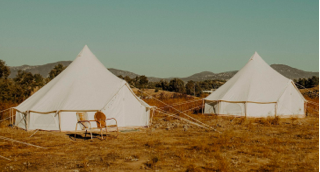LIVRAISON GRATUITE
Menu
-
- Boutique
- Tentes de camping
- Wall Tents
- Tente en toile
- Tentes cloches
- Tentes de festival
- Tentes de chasse
- Tentes Yourtes
- Tentes familiales
- Tente d'observation des étoiles
- Tentes cabanes
- Cadeaux de camping
- Tentes terrestres
- Poêles de tente
- Tente 4 personnes
- 6 Person Tents
- Tente 8 personnes
- 12 Person Tents
- Tente 6 personnes
- Équipement de camping
- Camping Chairs
- Shade Canopy Tents
- Camping Fans
- Prestations de service
- À propos
- Contact Us
- Reviews
-
- Connexion

Free Shipping

Pay No Sales Tax
30-Month Warranty
LIVRAISON GRATUITE
Tentes
À propos
Boutique


La liste LiT
Idées de glamping et de camping + ressources
How to Choose a Sleeping Bag for Camping
6 lire la lecture
The best sleeping bags guarantee you to wake up well-rested and ready to start your day outdoors. But with all the variety out there, how does a camper choose? To be honest, the best sleeping bag is relative to each person, but we’re here to help get you started. From temperature rating to size and shape, here is how to choose a sleeping bag for camping.
How to Choose a Sleeping Bag for Camping
Decide What Temperature Rating You Need
One of the most important factors of choosing a sleeping bag for camping is understanding the warmth you’ll require. This means recognizing the season you prefer camping, as well as temperature ratings on sleeping bags.
What Is a Sleeping Bag Temperature Rating?
Temperature ratings play an important part in choosing a sleeping bag. So important that a well-made sleeping bag will usually feature the rating directly in the product name. When you see a number rating like 35F, this indicates the sleeping bag has a temperature rating of 35 degrees Fahrenheit.
This average number always indicates the coldest temperature it can help you withstand. However, you should also consider the additional factors that come into play like windchill, your sleeping pad, and even what you choose to wear when you crawl into it.
Temperature Rating and Seasons
So, with this in mind, how do you choose a sleeping bag for camping? Well, to start, consider what seasons you plan to go camping. If you tend to camp in summer months, a 2-season sleeping bag will do just fine. But if you like winter camping or hot tent camping, you should consider a 4-season sleeping bag.
In general, here’s the temperature rating you’ll find in sleeping bags:
- 2-Season Sleeping Bags | Rating: 30F or higher
- 3-Season Sleeping Bags | Rating: 15F - 30F
- 4-Season Sleeping Bags | Rating: 15F or lower
Not sure what season you need? Always go warmer than you think you need. You never know how quick the weather could turn on you one brisk fall night, and you’re better safe than sorry. Plus, it’s far easier to cool your body off than it is to warm it, so unzipping your bag (or taking a breather outside to stargaze in the middle of the night) is always an option.
From personal experience, and as a woman, I tend to sleep colder and need a warmer sleeping setup when camping, whereas hubby even prefers to kick his feet out of the sleeping bag’s ventable footboxes. So when choosing a sleeping bag for camping, consider how you normally sleep too.

The Role a Camp Pad Plays
Now that you understand how to choose a sleeping bag for camping, let’s touch on the sleeping pad component. Many sleeping bags are given their temperature rating, assuming you’re also laying it on a sleeping pad, which offers a few extra inches of insulation between you and the cold earth. So remember: the sleeping pad beneath you will do more than bring comfort. It also brings extra warmth.
Fill Types: Down vs. Synthetic Insulation
At the two opposite ends of the spectrum for sleeping bag insulation are down feather and synthetic. Each insulation type brings its own set of advantages and disadvantages. So let’s break them down.
Down Feather
Sleeping bags with down filling offer a lightweight option with incredible warmth. Backpackers and campers mindful of pack weight lean into down-fill bags to lighten their load and ensure warmth on the trail. Down sleeping bags can also compact into a stuff sack rather well. Just give it a good shake to bring the loftiness back.
Down can last for years of camping trips, but one downside is that it is an initially expensive option. Also, while it performs excellently in cold weather, camping in rainy, damp, moisture-prone areas could cause it to make you feel chillier when you hit the hay. The feathers lose their loftiness. In short, down is best for dryer climates.
Another big con to down is allergies. Some folk might experience an allergic reaction to down, plain and simple. But keep in mind the severity of down allergens might go away. Some swear that shaking your down-filled bag outside the tent before throwing it in helps.
Keeping Down Ethical: If you care how your ducks and geese are treated, look for down-filled sleeping bags labeled with RDS (Responsible Down Standard) or TDS (Global Traceable Down Standard).
Synthetic Insulation
Sleeping bags with synthetic fill are the more affordable alternative. Synthetic bags also tend to dry a lot quicker in damper conditions and wetter climates (like the Pacific Northwest). And unlike down feathers, synthetic fill is generally non-allergenic.
The disadvantage of synthetic fill is that it is harder to compress. Now, that might be okay for car campers, but it’s just something to think about. Synthetic fill wouldn’t be the best choice for backpackers or mountaineers.
Recycled Synthetics: If sustainability is part of your mission, seek out sleeping bags with recycled synthetic materials.
Of course, you can choose a sleeping bag with a blend of the two insulations as well.
Choose a Sleeping Bag Shape
What shape of sleeping bag should you buy for camping? Below are the four basic sleeping bag shapes.
- Rectangular Sleeping Bags: This sleeping bag shape offers ample room to stretch out and roll over. Claustrophobic campers might prefer this sleeping bag shape to a mummy shape. Rectangular sleeping bags can also be unzipped to create more of a comforter-like topper you can throw off when weather gets hot.
- Mummy Sleeping Bags: Mummy sleeping bags will have you feeling snug as a bug. Designed to taper to fit snugly around your entire body, you might feel constricted. But the idea is to trap your body warmth. Stomach sleepers will have to roll the entire bag over with them. Backpackers prefer mummy styles because they reduce weight limit and size.
- Barrel Sleeping Bags: Barrel shaped bags, also called modified mummies, are a semi-rectangular size and cross between the mummy. They give more conformity and snugness, providing a bit more warmth.
- Double Sleeping Bags: If you share your tent with a partner, a double-size sleeping bag is a nice option. These sleeping bags are built for two, allowing you to snuggle up and keep each other warm. Plus, they consolidate and pack down into one bag.
Do your research, and you can also find some brands that offer double sleeping bags that unzip into two separate rectangular sleeping bags (a fantastic idea when your other half sets off with friends or does solo camping trips).

Extra Accessories and Features to Enhance Your Sleeping Bag
Zippers
Think about zipper placement, especially if you’re left-handed, for an easier reach. And don’t fall prey to a snagged zipper. Look for Y-shaped, anti-snag zippers and other snag-free touches around the zipper area like stiffer fabric lining or guard covering. It will ensure you never have to shimmy into the bag just to stay warm.
Waterproof Shell
Sleeping bags shells are often coated in a durable water repellent (DWR) finish over their polyester or nylon materials. This will keep any dampness away from mist or light rain and protect the down or synthetic fill.
A Bag Liner
Sleeping bag liners act as the sheet to your comforter. A liner is also useful in multiple ways. Instead of washing your entire sleeping bag shell after camping trips, a liner offers protection against sweat and dirt and makes an easily washable inside layer. And, if you get too hot during the night, the liner might be just enough. On the flipside, a fleece liner can add an extra layer of warmth.
Integrated Sleeping Bad Sleeve
Integrated sleeves can help keep your bag secured to the sleeping pad, which prevents it from slipping away or going astray in the middle of the night.
Pockets
You’ll often find sleeping bags with extra pockets here and there. These are for storing smaller items like headlamps or phones that often roll or slip away inside the tent. A nice feature to have!
Footbox Ventilation
As mentioned, some sleepers need to kick their feet out for extra breathability. If this is you, look for sleeping bags with footbox ventilation, often made as zippers at the foot of the bag.
Storage Sacks
- Stuff Sack: Choose a compression storage sack to transport your sleeping bag. This will help minimize space in your car or backpack.
- Compression Dry Bag: If you do packrafting or paddle into your campsites, a compression dry bag will save room in your raft and yak’s hull and keep your bag dry and moisture-free.
- Storage Sack: Storage sacks are ideal for down fill sleeping bags to keep the down lofty longer. Squishing the sleeping bag into a stuff sack is fine for a camping trip, but in between, it’s actually best to store it in a large mesh or cotton sack and even hang it in a closet.
Find the Right Sleeping Bag for Your Camping Experience
Use this guide on how to choose a sleeping bag and go explore the options. Hopefully, these tips will help you narrow down the selections and steer you in the right direction. However, at the end of the day, sometimes you have to test out the products to try them for yourself.
What sleeping bag features are a must-have to give you the best night’s sleep?
Related Resources

LA LISTE ÉCLAIRÉE 2 lire la lecture
Idées de camping dans la cour avec des enfants pendant le COVID-19
Le camping familial pendant le coronavirus peut être tout aussi une aventure que le camping dans l
LA LISTE ÉCLAIRÉE 4 lire la lecture
Can Glamping Businesses Survive a Recession?
Examining the Resilience of Luxury Camping Businesses Glamping, the luxurious cousin of traditional Blogues populaires
1. Qu’est-ce que le Glamping ?
2. Comment démarrer une entreprise de glamping
3. Créez une plate-forme de tente cloche
4. Les meilleures toilettes portables pour le camping
5. Comment installer et plier une tente cloche
6. Les meilleurs poêles de tente à cloche – Façons de chauffer une tente en toile
Produits populaires
S'abonner
Inscrivez-vous pour recevoir les dernières nouvelles sur les ventes, les nouveautés et les conseils
DEVENEZ UN INITIÉ
Nous partagerons périodiquement avec vous des idées, des sorties de tentes cloches, des offres spéciales et des notifications d'événements.


